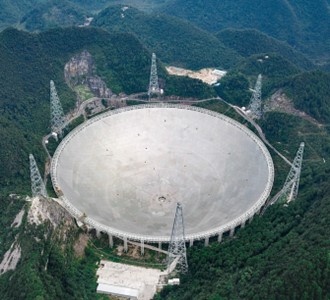Radioastronomía, el universo visto con otros ojos
DOI:
https://doi.org/10.36790/epistemus.v18i36.301Palabras clave:
longitud de onda, espectro electromagnético, antena, arreglos de antenas, radioastronomíaResumen
Ya que nuestros ojos pueden ver solamente en un rango específico de longitudes de onda del espectro electromagnético, llamada región visible, el estudio del Universo en este intervalo particular es muy común e intuitivo para los humanos. Sin embargo, es posible descubrir nuevas estructuras y fenómenos al observar los mismos objetos celestes en longitudes de onda diferentes a las visibles. En este trabajo se describe una interesante, aunque poco conocida, rama de la astronomía, la radioastronomía. Se presenta algo de historia, técnicas de observación y descubrimientos recientes y sorprendentes logrados por los radioastrónomos.
Descargas
Citas
K.G. Jansky, “Directional Studies of Atmospherics at High Frequencies,” Proc. Inst. Rad. Eng., vol. 20, num.12, pp.1920-1932, Diciembre 1932. DOI:10.1109/JRPROC.932.227477 DOI: https://doi.org/10.1109/JRPROC.1932.227477
K.G. Jansky, “Radio Waves from Outside the Solar System” , Nature, vol. 132, 3323, pp. 66-66, Mayo 1933. DOI:10.1038/132066a0 DOI: https://doi.org/10.1038/132066a0
K.G. Jansky, “Electrical Disturbances apparently of Extraterrestial Origin”, Proc. Inst. Rad. Eng., vol. 21, num. 10, pp. 1387-1398. Octubre 1933. DOI:10.1109/JRPROC.1933.227458 DOI: https://doi.org/10.1109/JRPROC.1933.227458
F.H. Shu, F.C. Adams, S. Lizano, “Star Formation in Molecular Clouds”, Ann.Rev.Astron.Astrophys., 25, pp. 23-81, Septiembre 1987. DOI:10.1038/132066a0 DOI: https://doi.org/10.1146/annurev.aa.25.090187.000323
ALMA Partnership, C.L. Brogan, L.M. Pérez, T.R. Hunter, W.R.F. Dent et al. “The 2014 ALMA Long Baseline Campaign: First Results from High Angular Resolution Observations Toward the HL Tau Region”, Julio 2015. DOI:10.1088/2041-8205/808/1/L3 DOI: https://doi.org/10.1088/2041-8205/808/1/L3
A.Isella, M. Benisty, R. Teague, J. Bae, M. Keppler et al., “Detection of Continuum Submillimeter Emission Associated with Candidate Protoplanets”, ApJL, 879, L25, Julio 2019. DOI:10.3847/2041-8213/ab2a12 DOI: https://doi.org/10.3847/2041-8213/ab2a12
L. Woltjer, “Emission Nuclei in Galaxies”, ApJ, 130, pp. 38-44, Febrero 1959. DOI: 10.1086/146694 DOI: https://doi.org/10.1086/146694
E.E. Salpeter, “NOTES: Accretion of Interstellar Matter by Massive Objects”, ApJ, 140, pp. 796-800, Agosto 1964. DOI: 10.1086/147973 DOI: https://doi.org/10.1086/147973
J.M. Bardeen, “Kerr Metrics Black Holes”, Nature, 226, pp. 64-65, Abril 1970. DOI: 10.1038/226064a0 DOI: https://doi.org/10.1038/226064a0
G.R. Burbidge, “The Nuclei of Galaxies”, Ann.Rev.Astron.Astrophys., 8, pp. 369-460, 1970. DOI: 10.1146/annurev.aa.08.090170.002101 DOI: https://doi.org/10.1146/annurev.aa.08.090170.002101
V.L. Ginzburg y L.M. Ozernoy, “On the Nature of Quasars and Galactic Nuclei”, Astrophysics and Space Science, 50, pp. 23-41, Agosto 1977. DOI: 10.1007/BF00648516 DOI: https://doi.org/10.1007/BF00648516
É. A. Dibai, “Mass of the Central Bodies of Active Galactic Nuclei”, Soviet Astronomy Letters, 3, pp. 1-3, Febrero 1977.
A. Cavaliere, “Active Galactic Nuclei”, in 16th International Cosmic Ray Conference, 14, pp. 91-103, University of Tokyo: Institute for Cosmic Ray Research, Ed. M. Saburo, 1979.
Netzer, H., “Revisiting the Unified Model of Active Galactic Nuclei”, Ann.Rev.Astron.Astrophy., 53, pp. 365-408, Agosto 2015. DOI:https://doi.org/10.1146/annurev-astro-082214-122302 DOI: https://doi.org/10.1146/annurev-astro-082214-122302
Event Horizon Telescope Collaboration, K. Akiyama, A. Alberdi, W. Alef, K. Asada, R. Azulay, et. al., “First M87 Event Horizon Telescope Results. I. The Shadow of the Supermassive Black Hole ”, ApJL, 875, L1, Abril 2019. DOI: https://doi.org/10.3847/2041-8213/ab0ec7 DOI: https://doi.org/10.3847/2041-8213/ab0ec7
Event Horizon Telescope Collaboration, K. Akiyama, A. Alberdi, W. Alef, K. Asada, R. Azulay, et. al., “First M87 Event Horizon Telescope Results. IV. Imaging the Central Supermassive Black Hole ”, ApJL, 875, L4, Abril 2019. DOI: 10.3847/2041-8213/ab0e85 DOI: https://doi.org/10.3847/2041-8213/ab0e85
Event Horizon Telescope Collaboration, K. Akiyama, “First M87 Event Horizon Telescope Results. VI. The Shadow and Mass of the Central Black Hole ”, ApJL, 875, L6, Abril 2019. DOI: 10.3847/2041-8213/ab1141 DOI: https://doi.org/10.3847/2041-8213/ab1141
G. Reber, “Notes: Cosmic Static”, ApJ, 91, pp. 621-624, 1940. DOI:10.1086/144197 DOI: https://doi.org/10.1086/144197
G. Reber, “Cosmic Static”, ApJ, 100, pp. 279-287, Mayo 1944. DOI:10.1086/144668 DOI: https://doi.org/10.1086/144668
G. Reber, “Radio Astronomy”, Sci. Am., Vol. 181, Núm. 3, pp. 34-41, Septiembre 1949. DOI:10.1038/scientificamerican0949-34 DOI: https://doi.org/10.1038/scientificamerican0949-34
D. Lynden-Bell y M.J. Rees, “On Quasars, Dust and the Galactic Center”, MNRAS, 152, pp. 461-475, Julio 1971. DOI: 10.1093/mnras/152.4.461 DOI: https://doi.org/10.1093/mnras/152.4.461
C. Hazard y S. Mitton, “Active Galactic Nuclei”, Cambridge University Press, Abril 1980.
R. Genzel y C.H. Townes, “The Nucleus of our Galaxy”, Ann.Rev.Astron.Astrophys., 25, pp. 377-423, Septiembre 1987. DOI: 10.1146/annurev.aa.25.090187.002113 DOI: https://doi.org/10.1146/annurev.aa.25.090187.002113
R. Genzel, D. Hollenbach y C.H. Townes, “The Nucleus of our Galaxy” , Rep. Prog. Phys. 57, 417, Mayo 1994. DOI:10.1088/0034-4885/57/5/001 DOI: https://doi.org/10.1088/0034-4885/57/5/001
A.M. Ghez, G. Duchêne, K. Matthews, S.D. Hornstein, A. Tanner et al., “The First Measurement of Spectral Lines in a Short-Period Star Bound to the Galaxy´s Central Black Hole: A Paradox of Youth”, ApJ, 586, L127-L131, Abril 2003. DOI:10.1086/374804 DOI: https://doi.org/10.1086/374804
M.G. Revnivtsev, E.M. Churazov, S.Yu. Sazonov, R.A. Sunyaev, A.A. Lutovinov et al., “Hard X-ray View of the Past Activity of SgrA* in a Natural Compton Mirror”, Astron.Astrphys., 425, L49-L52, Agosto 2004. DOI: 10.1051/0004-6361:200400064 DOI: https://doi.org/10.1051/0004-6361:200400064
R. Lu, T.P. Krichbaum, A.L. Roy, V.L. Fish, S.S. Doeleman et al., “Detection of Instrinsic Source Structure at 3 Schwarzschild Radii with Millimeter-VLBI Observations of SAGITARIUS A”, ApJ, 859, 60 , Mayo 2018. DOI: 10.3847/1538-4357/aabe2e DOI: https://doi.org/10.3847/1538-4357/aabe2e
I. Heywood, F. Camilo, W.D. Cotton, F. Yusef-Zadeh, T.D. Abbott, et al. “Inflation of 430-parsec bipolar radio bubbles in the Galactic Centre by an energetic event ”, Nature, 573, pp. 235-237, Septiembre 2019. DOI: 10.1038/s41586-019-1532-5 DOI: https://doi.org/10.1038/s41586-019-1532-5
Event Horizon Telescope Collaboration, K. Akiyama, A. Alberdi, W. Alef, J.C. Algaba, R. Anantua, et. al., “First Sagittarius A* Event Horizon Telescope Results. I. The Shadow of the Supermassive Black Hole in the Center of the Milky Way”, ApJL, 930, L12, Mayo 2022. DOI: 10.3847/2041-8213/ac6674 DOI: https://doi.org/10.3847/2041-8213/ac6674
Event Horizon Telescope Collaboration, K. Akiyama, A. Alberdi, W. Alef, J.C. Algaba, R. Anantua, et. al., “First Sagittarius A* Event Horizon Telescope Results. III. Imaging of the Galactic Center Supermassive Black Hole ”, ApJL, 930, L14, Mayo 2022. DOI: 10.3847/2041-8213/ac6429 DOI: https://doi.org/10.3847/2041-8213/ac6429
Event Horizon Telescope Collaboration, K. Akiyama, A. Alberdi, W. Alef, J.C. Algaba, R. Anantua, et. al., “First Sagittarius A* Event Horizon Telescope Results. IV. Variability, Morphology, and Black Hole Mass”, ApJL, 930, L15, Mayo 2022. DOI: 10.3847/2041-8213/ac6736 DOI: https://doi.org/10.3847/2041-8213/ac6736

Publicado
Cómo citar
Número
Sección
Licencia
Derechos de autor 2024 EPISTEMUS

Esta obra está bajo una licencia internacional Creative Commons Atribución-NoComercial-CompartirIgual 4.0.
La revista adquiere los derechos patrimoniales de los artículos sólo para difusión sin ningún fin de lucro, sin menoscabo de los propios derechos de autoría.
Los autores son los legítimos titulares de los derechos de propiedad intelectual de sus respectivos artículos, y en tal calidad, al enviar sus textos expresan su deseo de colaborar con la Revista Epistemus, editada semestralmente por la Universidad de Sonora.
Por lo anterior, de manera libre, voluntaria y a título gratuito, una vez aceptado el artículo para su publicación, ceden sus derechos a la Universidad de Sonora para que la Universidad de Sonora edite, publique, distribuya y ponga a disposición a través de intranets, internet o CD dicha obra, sin limitación alguna de forma o tiempo, siempre y cuando sea sin fines de lucro y con la obligación expresa de respetar y mencionar el crédito que corresponde a los autores en cualquier utilización que se haga del mismo.
Queda entendido que esta autorización no es una cesión o transmisión de alguno de sus derechos patrimoniales en favor de la mencionada institución. La UniSon le garantiza el derecho de reproducir la contribución por cualquier medio en el cual usted sea el autor, sujeto a que se otorgue el crédito correspondiente a la publicación original de la contribución en Epistemus.
Salvo indicación contraria, todos los contenidos de la edición electrónica se distribuyen bajo una licencia de uso y Attribution-NonCommercial-ShareAlike 4.0 International (CC BY-NC-SA 4.0) Puede consultar desde aquí la versión informativa y el texto legal de la licencia. Esta circunstancia ha de hacerse constar expresamente de esta forma cuando sea necesario.















